Potatoes are one of the easiest vegetables to grow, but rather than planting them from seeds produced by the flowers of the plant, they are generally grown by planting portions of the root structure, known as seed potatoes. Seed potatoes are tubers that you can use to grow new potatoes that will be genetically identical to the parent potato. Potatoes grow more expediently by this kind of vegetative propagation, and for most home gardeners the process is easier than growing from seeds. Typically it can take about 60 to 90 days for potatoes to grow after planting. Read more about how to plant seed potatoes in the early spring so you can harvest them by mid-summer.

When to Plant Seed Potatoes
Potatoes do best in full sun. They can be planted in the early spring two to four weeks prior to the expected last frost date in your area. Seed potatoes planted in soil that is too cold or soggy may rot.1 Generally, potatoes will not grow until the soil temperature has reached at least 45 degrees Fahrenheit. You can plant a second crop as late as June 15th depending on location and harvest the potatoes as late as possible. Potato plants will tolerate a light frost, but protect plants from freezes with row covers, or harvest them before a freeze arrives.
Working With Potatoes
Potatoes are aggressively rooting plants and will produce the best crop when planted in light, loose, well-drained soil. Potatoes prefer slightly acidic soil with a pH of 6.0 to 6.5—acidic to neutral. However, potatoes are prolific growers and usually adapt to poor soil and climate conditions. Make sure to rotate where you plant potatoes in the garden, as soil-borne diseases can linger in the ground and affect future crops.2
When selecting seed potatoes, do not use the potatoes you buy at the grocery store. Grocery produce is often treated with a growth inhibitor, which keeps potatoes fresher longer but also prevents sprouting or stunts growth.
Organically grown potatoes may be free of growth inhibitors, but they are prone to any diseases carried over from their growth period (such as ring rot or fusarium wilt).3 You need disease-free, certified seed potatoes. Before planting, examine the seed potatoes and discard any that have soft spots, cracks, bruises, or signs of rotting.
Before you plant, you may also decide to “chit” (pre-sprout) the potatoes. If you decide to encourage stem growth on your potatoes, this step will add two to four weeks to the planting process. However, many gardeners find that chitting potatoes produces a quicker, slightly larger potato.
What You’ll Need
Equipment / Tools
- Knife
Materials
- Seed potatoes
- Powdered sulfur (optional)
- Bag (optional)
- Egg carton, box, tray, or screen (optional)
Instructions
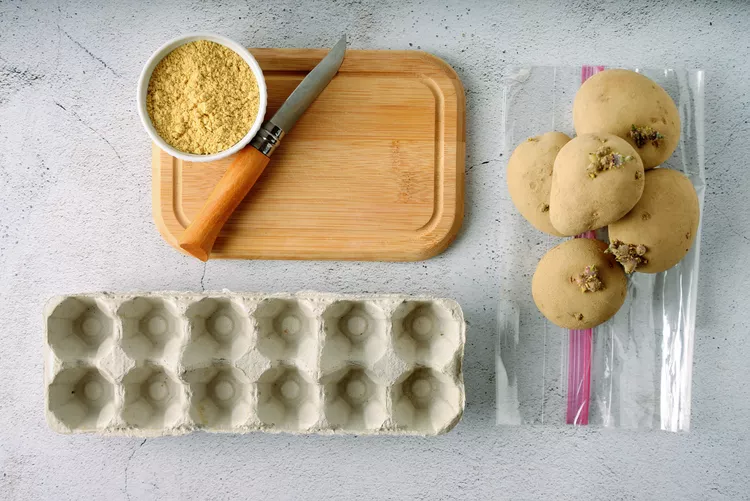
Chit the Potatoes (Optional)
Although potatoes will sprout in the dark, you will get long, pale shoots that easily break. Instead, place them in a cool spot with bright light for 2 to 4 weeks. This way, the sprouts will grow stocky, sturdy, and dark green. This process is also called greening. You can place your seed potatoes upright in an egg carton or box, on a tray, or screen with the majority of buds (“eyes”) facing up. Do not pile them atop one another. You can start this process one month before your outdoor planting date.
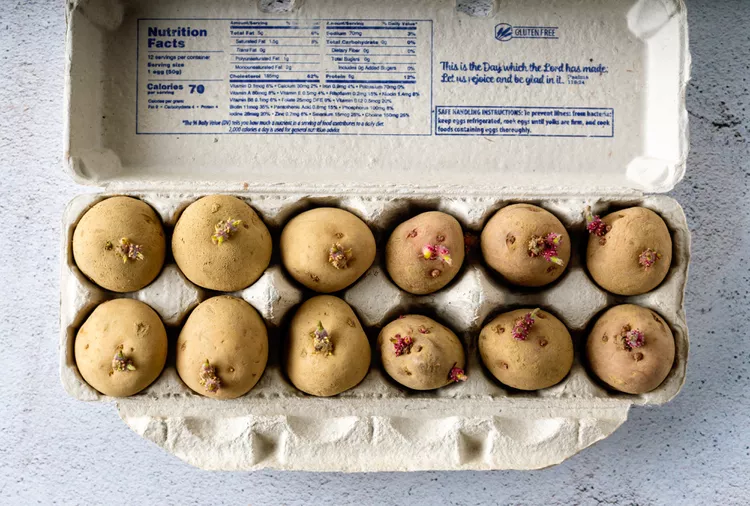
Cut the Potatoes (Optional)
You do not need to plant a whole, intact potato. Seed potatoes can be cut into pieces before planting. Each piece should have at least one “eye” each—a bud that will sprout into a new plant. Use a sharp, clean knife to cut the seed potatoes into 2-inch squares. If you are going to cut them, do it about two days before you plan to plant. This allows the pieces to form a callus or seal, which prevents rotting while the pieces sprout and take root. If your seed potato is smaller than a ping pong ball, though, plant it whole.
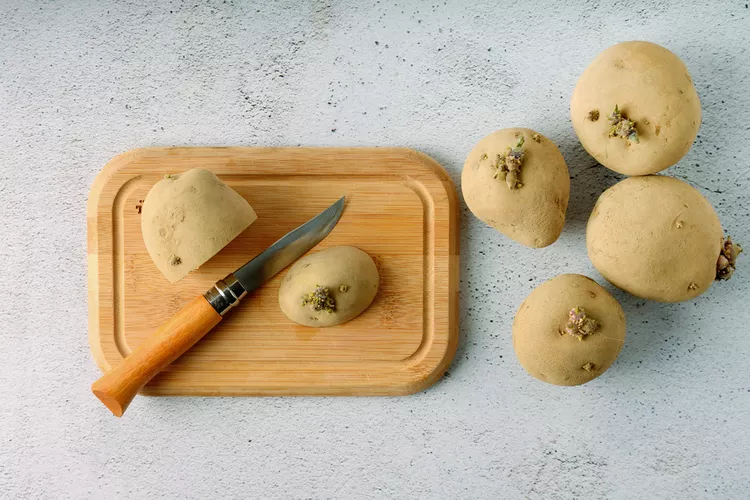
Plant the Sprouted Potatoes
Plant the potatoes as soon as the sprouts are 1/2 inch to 1 inch long. Handle the seed potatoes carefully, so the sprouts do not break off or become damaged. Plant potatoes with the sprouts facing up and cover lightly with soil. If you’ve cut the seed potatoes, make sure the cut side is facing down.
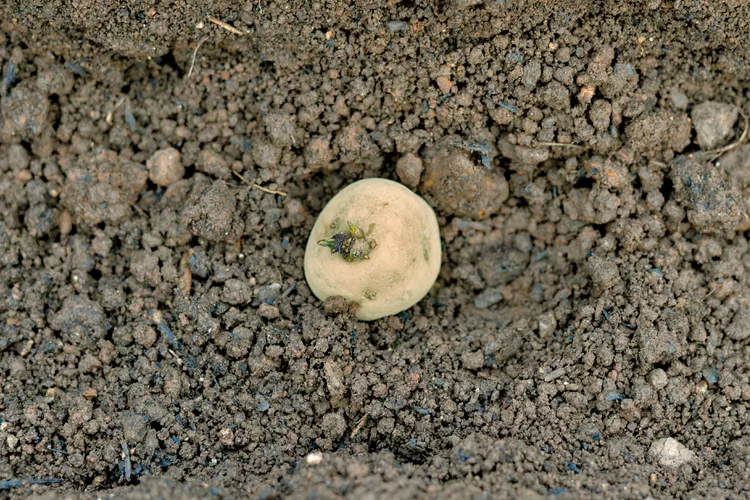
Plant in Rows
Potatoes grow best planted in rows spaced 3 feet apart. Plant the seed potatoes in a trench that is 6 to 8 inches deep. Place cut side down, with eyes facing up. Space the seed potatoes 12 to 15 inches apart. Fill the trench with 4 inches of soil. As the plants grow, add more soil, mounding it up around the plants.
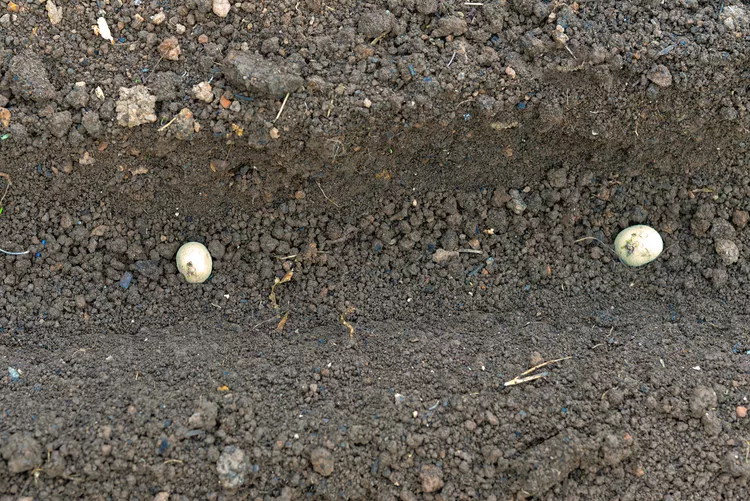
Water Well
Keep potatoes well-watered throughout summer, especially when flowering. During flowering, the plants begin to create the tubers—the edible potatoes. Potatoes need 1 to 2 inches of water per week to produce well.
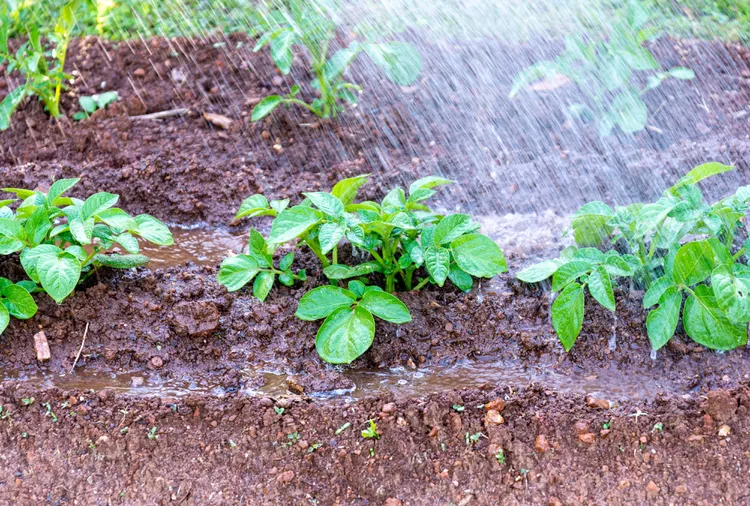
Harvest the Mature Potatoes
When the foliage turns yellow, discontinue watering to begin the curing process for harvesting. You can harvest baby, or “new” potatoes two to three weeks after flowering ceases. Dig around the plants carefully to remove new potatoes for fresh eating, and leave the smaller potatoes to continue growing.
For potatoes that you plan to store, harvest the crop two to three weeks after the foliage dies back. Carefully loosen the potatoes with a garden fork and remove them from the bed. If the weather is dry, leave the potatoes in the garden, unwashed, for two to three days to cure, or move them to a protected area, such as a garage or shed, to cure.
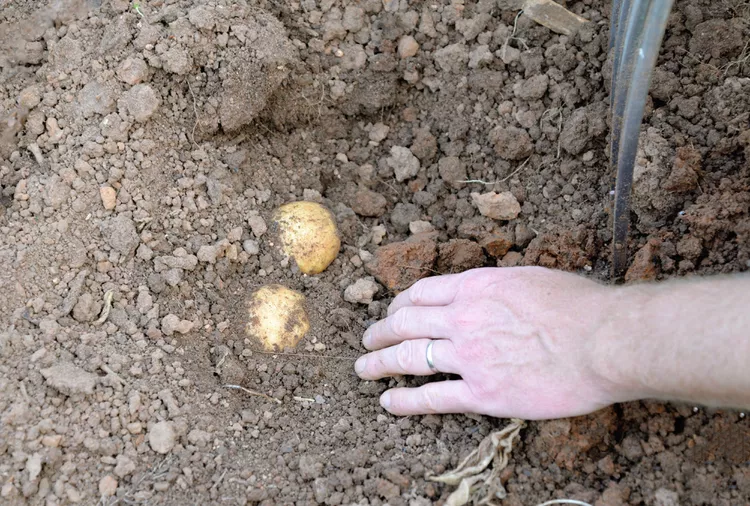
Seed Potato Tips
- You do not have to chit the potatoes to get a good crop. However, you might want to chit your potatoes if you notice them beginning to sprout or if you want an earlier harvest date. If you plan to eventually cut them before planting them, chit before cutting them.
- When planting whole seed potatoes or pieces of potatoes, in general, more eyes per piece equals more potatoes. Smaller potatoes with one or two eyes per piece mean fewer potatoes, but they will be larger.
- To further protect your seed potatoes, you can dust them with powdered sulfur right after cutting them and before planting them. Place the potatoes in a bag, add the sulfur and shake. Then lay the pieces out and let them dry for three to four days.
- If you have to postpone planting because of weather or some other reason, move the seed potatoes to a cooler spot to slow down their growth. Don’t wait too long; the potatoes may start to dehydrate and shrivel.
- On average, one pound of seed potatoes should yield about 10 pounds of edible potatoes. One pound of seed potatoes should fill a 5- to 8-foot row, depending on the variety.
- It’s easy to plant seed potatoes in bags and pots, both of which are good alternatives if you have issues with voles in the garden. The planting process is the same for bags and pots. Fill a grow bag halfway with potting mix, plant the seed potatoes, and continue to add more soil to the bag as the potatoes grow. To harvest, spread out a tarp or sheet, and dump the bag. Kids especially enjoy sorting through the bag to find potatoes!


Learning how to plant seed potatoes from this article was incredibly informative! I appreciate the detailed step-by-step instructions, from preparing the soil to spacing and planting the seed potatoes correctly. The tips on selecting the right variety of potatoes and ensuring proper soil conditions are especially helpful for beginners like myself. Excited to put this knowledge into practice and grow my own delicious potatoes!
Thank you for providing such clear guidance on planting seed potatoes! The article’s emphasis on choosing healthy, disease-free seed potatoes and properly preparing them for planting sets the foundation for a successful harvest. I also appreciate the advice on spacing, watering, and hilling the plants as they grow. With these expert tips, I feel more confident in starting my potato garden and look forward to enjoying homegrown spuds.
This article provides a comprehensive guide on how to plant seed potatoes, making it accessible even for beginners. I found the step-by-step instructions easy to follow, especially the tips on selecting the right variety of seed potatoes and preparing the soil properly. The inclusion of helpful images enhances understanding and makes the process seem less daunting.
I appreciate the detailed explanation of the different methods for planting seed potatoes, such as trench planting and container planting. The article’s emphasis on proper spacing and depth for planting ensures optimal growth and yield. Additionally, the troubleshooting tips for common potato-growing problems offer valuable insights for overcoming challenges and maximizing success in the garden.
As someone interested in starting a potato garden, I found this article incredibly informative. The guidance on choosing the right planting location based on sunlight and soil quality is particularly helpful for ensuring successful potato cultivation. I also appreciate the tips on pest and disease management, which provide practical solutions for protecting potato crops and promoting healthy growth.
Planting seed potatoes is a straightforward process that yields delicious homegrown potatoes, perfect for both novice and experienced gardeners alike.